Which LED lights are better. How to choose a powerful rechargeable LED flashlight - practical advice
08.11.2013
1. Why LED better than a lamp incandescent?
LEDs have several advantages over incandescent lamps:
- it is not as easy to break as a lamp. In the lamp, light is emitted by a fragile spiral, which is enclosed in an equally fragile glass flask. The LED shines with a small semiconductor area on which a phosphor is applied - light-emitting paint. All this is protected by a glass or silicone lens.
- it is more efficient than a lamp. Efficiency of modern powerful LEDs reaches 130 or more lumens per 1 Watt of power consumption. For comparison, the efficiency of incandescent lamps does not reach 30 Lm/W. Due to this advantage, an LED flashlight will shine longer than a lamp flashlight using the same batteries.
- life time. For LEDs it is usually at least 50,000 hours of continuous operation. For a lamp, 5000 hours is a very good indicator. In addition, the service life of the LED is not reduced even with very frequent switching on and off. LED lights can have strobe, SOS and similar flashing signals, which lamp lamps do not have.
- dimensions. LED flashlights can be very small.
- ease of focusing. LED light is distributed much more evenly than lamp light. The stain becomes more even.
- allow you to adjust brightness over a wide range. The brightness of the LED is controlled by the supply current. The higher the current, the higher the brightness. Each diode model has its own maximum permissible supply current. If this current is exceeded, the LED overheats, its service life is sharply reduced, and its efficiency decreases.
2. What is Lumen?
Lumen is a unit of measurement of luminous flux. Without going into the essence of physical definitions, one lumen can be characterized as the light emitted by one wax candle, but not spreading in all directions, but collected into a beam of a certain shape.
In the flashlight world, there are two well-established concepts related to lumens.
Bulb lumen or lamp/diode lumens. This is the luminous flux emerging directly from a lamp or diode without taking into account losses in optics.
Torch lumen or flashlight lumens. The luminous flux at the exit of the flashlight already includes losses on the reflector, glass or lens.
Different manufacturers may use different ways to specify the lumen output of their flashlights. Some indicate bulb lumens, others - torch, manufacturers of cheap Chinese flashlights of such brands as Ultrafire, Aurora, etc. generally indicate the maximum available for specific model LED values of luminous flux, while overestimating the real luminous flux of the flashlight by two or more times.
On August 18, 2009, the ANSI/NEMA FL-1 standard was adopted, allowing more reliable comparison of flashlight parameters. The standard includes the following indicators: emitted luminous flux, operating time, peak light intensity, light range, impact resistance and water resistance.
The standard is currently used by such manufacturers as Maglite, Princeton Tec, Surefire, Petzl, Energizer, Streamlight, Black Diamond, Duracell, FenixLight and others.
3.What is IPX-8?
IP - international standards for protecting equipment from exposure environment.
The first number, replaced by an “X”, indicates complete protection of the flashlight from dust.
The second, “8”, guarantees water resistance when the flashlight is completely immersed in water to a depth of more than 1 meter. The maximum permissible duration and depth of immersion may be additionally specified by the manufacturer. You can read more in our article.
4. What is anodizing?
Anodizing is a protective and/or decorative coating of metal. Protects the flashlight body from oxidation, does not conduct electric current, and improves appearance.
The anodized body of the flashlight is resistant to abrasion, but is resistant to impacts on hard surfaces. Upon impact, the inner, relatively soft part of the body is dented and a chip is formed.
There are two types in lanterns: degrees II and III. The higher the grade, the thicker and stronger the anodization.
Anodizing is applied electrochemically. The part is immersed in an acid solution and an electric current is passed through it. The thickness, hardness and color of anodization depend on the temperature of the solution, the density of the transmitted current and the additional dyes used.
Suitable for both aluminum and titanium flashlights.
5. Why do some flashlights have smooth glass, while others have a lens?
Flashlights can be reflective or lens.
A reflector is a reflective bowl in the center of which there is an LED or lamp. It collects light from a source into a beam of a certain shape. Typically, the beam formed by the reflector appears as a bright central spot and a less bright area of lateral illumination. This optical system is protected from water and dust by flat glass with a rubber gasket.
A lens or a whole system of lenses also collects light into a beam. When using lenses, the beam can have a variety of shapes. From a uniform circle without a central bright spot to a narrow, almost laser beam with no side illumination at all.
The focusing of a flashlight with a lens can be variable, that is, the same flashlight in different positions of the lens can shine well into the distance and illuminate evenly and comfortably near.
A disadvantage of some variable focus flashlights is poor sealing. When immersed in water, liquid leaks inside, disrupting the operation of the electronics.
6. Reflector. Should you choose smooth or wrinkled?
A smooth reflector (in English terminology - smooth) is used in long-range flashlights. The light spot has a bright central spot and a sharp transition to an area of weak side illumination. At the same time, for a real long-range flashlight, the diameter of the reflector is no less important. The larger it is, the better the focusing. You shouldn’t expect long-range miracles from a flashlight with a smooth reflector with a diameter of 1 cm...
The wrinkled (Orange Peel) reflector has a rough structure that smoothes out the sharp transition from the central spot to the side illumination area. This flashlight is convenient to use at short distances. The light spot is obtained with a less bright center, but large.
7.Which LED is better, warm or cold?
LEDs can have different color temperatures. That is, the light of an LED can have shades from warm yellowish, like that of a familiar incandescent light bulb, to cold, giving off a blue tint.
Which diode to choose depends on the tasks you set for yourself and individual perception. For outdoor use in summer, a warm LED is preferable.
Cold light appears brighter, but has worse color rendering compared to warm light. This is especially true for shades of red and yellow. Green grass may look gray in the light of a cold LED.
If you intend to use it indoors or in winter, when everything around is white or gray, then color rendering flaws are not so important.
For professional use, especially if you need to clearly distinguish the smallest shades of color of illuminated objects, LEDs may be completely unsuitable.
8.Xenon or LED, what's the difference?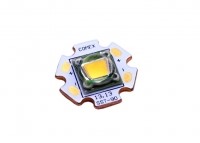 Xenon or HID (High Intensity Discharge) lamps are similar to incandescent lamps with the difference that they emit light not from a filament, but from a high-voltage electrical discharge enclosed inside a glass bulb.
Xenon or HID (High Intensity Discharge) lamps are similar to incandescent lamps with the difference that they emit light not from a filament, but from a high-voltage electrical discharge enclosed inside a glass bulb.
Xenon lamps have similar disadvantages to incandescent lamps, such as fragility, short service life relative to LEDs, and large sizes. Also among the disadvantages are the high price, the inability to adjust brightness, and demanding power supply. For their operation, xenon lamps require a special starting device and ballast, batteries capable of delivering very high current. Advantages - high efficiency, good color rendering, the ability to obtain very powerful light sources with excellent focusing, which is not yet available for LEDs.
Some flashlight manufacturers call xenon lamps with a regular spiral, but containing xenon or halogen vapors under the bulb. Halogen lamps have a longer service life and efficiency compared to conventional incandescent lamps, and do not require additional devices for operation.
9.Rechargeable batteries or batteries, which is more profitable?
If the flashlight is used regularly, every day or even every weekend for several hours, then the batteries and charger for them will quickly pay for themselves.
If you have a flashlight “just in case,” it is more profitable to power it with batteries. Also, if you go on a long hike and there will be no way to charge the batteries, a spare battery will come in handy.
10. Which flashlight should a hunter buy?
- durable and reliable,
- the flashlight must withstand recoil,
- be able to be installed on a weapon,
- have a minimum number of modes and simple controls to eliminate the possibility of confusion at the moment of shooting,
- the flashlight must be long enough for the caliber used,
- have a tactical button so that the flashlight turns on before it clicks,
- be able to use a remote button,
- have reliable batteries with a long shelf life. The ideal option is CR123A batteries,
- the flashlight should not greatly affect the balance of the weapon, accordingly, the less weight the better.
These requirements are met by tactical series from many manufacturers: Surefire, Streamlight, Fenix, JetBeam, Olight, Magicshine
11. Flashlight for fishing. Which one should I buy?
The fisherman should have both hands free, which means it’s worth paying attention to headlamps. Cool LEDs cannot penetrate fog or haze over water. Their light illuminates the water particles themselves hanging in the air, which only interferes with the illumination of the target. Based on this, the flashlight should have a “warm” LED, lamp or combined.
Headbands that meet these requirements are produced by Petzl, Fenix, Sunree, Zebralight.
12. Car flashlight, what to choose?
Depends on the tasks of the motorist.
If the flashlight will be used to repair a car or troubleshoot problems on the road, then you need free hands and a headlamp with a diffuse beam. It is better to use batteries, easily accessible AA type or a rechargeable flashlight with charging from the cigarette lighter.
If we are talking about off-road testing, where the flashlight is used for navigation, a high-power HID or LED floodlight is a good choice.
For a “just in case” flashlight that can replace a mount in an emergency, you should choose the appropriately sized Maglite S6D or Streamlight UltraStinger model.
13. Which lantern is better for a dacha?
The one that won't get lost is large and visible, perhaps brightly colored.
Protected from dust, water and drops. With housing made of aluminum or durable plastic.
On batteries, preferably readily available in rural areas - AA or D., or with a built-in battery and charging from a 220v network or even with a radio. You can find lanterns for your dacha in the camping lanterns section.
14. Bicycle light, is there such a thing?
For cycling, you can use either special bicycle lights (cycle lights) or regular hand-held ones.
Bicycle lights usually consist of two blocks connected by a wire. A unit with a lamp or LED is mounted on the handlebars, and the second, battery-powered one, is located on the frame or under the saddle.
There are many bike racks available for handheld lights. The simplest thing, made by yourself, is two metal clamps connected together. One is put on the steering wheel, the second one holds the light.
Long-range lights are not suitable for cycling. For a comfortable ride, the flashlight should illuminate the road with a fairly wide beam.
The use of LEDs in flashlights has long passed from fashion trends to a theoretically and practically justified necessity. They, unlike incandescent lamps, are ideal for use in directional light sources. Numerous features of the light-emitting matrix of diodes make it possible to obtain devices with parameters that are even theoretically impossible for an incandescent lamp to approach.
Advantages of LEDs over incandescent lamps
With comparable brightness, the energy consumption of the diode matrix and the size of the light-emitting element are significantly smaller than any incandescent lamp. This allows you to create compact but extremely powerful portable lighting fixtures. The angle of the light beam of the matrix is from 30 degrees, which significantly increases the efficiency of the light source and facilitates focusing.
Disadvantages of LED sources
A small crystal size with high power has a high heat dissipation coefficient, requiring passive or forced cooling. The sensitivity of the LED matrix to the voltage and current levels of the power source requires the use of current and voltage stabilization circuits.
Types of Powerful LED Flashlights
There are two types of high power flashlights, depending on the purpose:
- signal;
- lighting
 Signal lights designed to create a narrow beam of light that maintains focus over long distances. This type produces a spot of high brightness even at a distance of 600-800 meters.
Signal lights designed to create a narrow beam of light that maintains focus over long distances. This type produces a spot of high brightness even at a distance of 600-800 meters.
 IN lighting lanterns reflectors of scattering type. They provide bright illumination with a beam angle of approximately 120 degrees.
IN lighting lanterns reflectors of scattering type. They provide bright illumination with a beam angle of approximately 120 degrees.
The brightest LED flashlights
 The most powerful industrial flashlight was created by Polarion based on a xenon lamp.
The most powerful industrial flashlight was created by Polarion based on a xenon lamp.
Its luminous flux is 5200 lumens, and the brightness is so high that it illuminates objects at a distance of 1500 meters. Despite its impressive parameters, it has a lot of shortcomings. The lamp life is only 2500-3000 hours; powerful batteries barely last an hour of full operation.
But in fact this is far from the limit.
A homemade LED flashlight with a luminous flux power of 18,000 lumens was made in Germany!!!
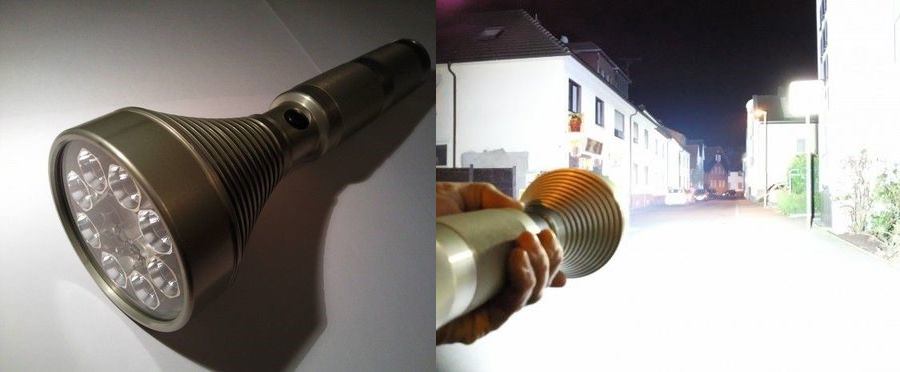
It is so bright that it can easily burn out the retina of the eye.
How to choose an LED flashlight
Before we start choosing, let's figure out how they differ led lights.
Luminous flux power:
- from 60 lumens to 4600 lumens.
Power supply type:
- batteries;
- batteries;
- combined (batteries with built-in generator).
Focus type:
- signal (search);
- lighting.
The power of the flashlight determines how far it will shine.
Capacity of batteries of various types. Battery capacity AA – 2000-2500 mAh, AAA – 800-1000 mAh The type of power source determines its operating time.
How to calculate the operating time of batteries or accumulators.
The LED crystal supply voltage is 3.2-3.4V. Average current consumption is 300mA per 100 lumens.
When powering a flashlight with a brightness of 50 lumens from 2 AA batteries with a total capacity of 2000 mAh, they will be enough for 13 hours of continuous operation of the flashlight:
Operating time = 2000mAh / 150mA (LED current)
How to choose a household LED flashlight
For domestic needs, high power is not needed. A more important parameter is the battery life. If you plan to use the flashlight regularly, it is better to consider battery-powered models with a built-in generator. Even if you forget to recharge it, and this usually happens at the most necessary moment, the built-in generator will not allow you to be left without lighting.

Powerful light sources are purchased by those who are interested in fishing, hunting, or often spend the night outdoors.
How to choose a powerful rechargeable LED flashlight
Depending on the operating conditions, we select the type of housing protection
- IP50 protection class provides protection from dirt and dust;
- protection class IP65-69 - products that are not afraid of moisture, and with the marking 67-69 you can even be submerged under water.
Choose the LED power based on your needs.
How to convert an ordinary flashlight into an LED one
The price of powerful flashlights is from 20 to 500 dollars. At the same time, for a couple of dollars you can buy an ordinary flashlight with a high-quality body, which, with minimal investment, will turn into a powerful light source using diodes.
Which LED is best for a flashlight? The LED used must be rated for voltages up to 5 volts and have a compact size.
The brightest LED for a flashlight
If you want to build a very powerful flashlight with minimal investment, pay attention to a model such as Luminus SST-90-WW Star 30W. Its supply voltage is 3-3.7 volts, which will make the flashlight quite compact. Luminous flux at current consumption 9000 mA 2300 lumens. It is clear that it will not be able to work normally from AA batteries, much less from ordinary batteries.
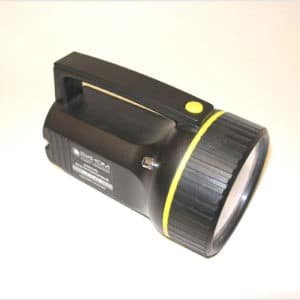 To make such a flashlight, it is better to use a massive housing in which you can install one or two 6-volt, 6-Ah batteries.
To make such a flashlight, it is better to use a massive housing in which you can install one or two 6-volt, 6-Ah batteries.
To cool the matrix you will need a massive heatsink and a power driver.
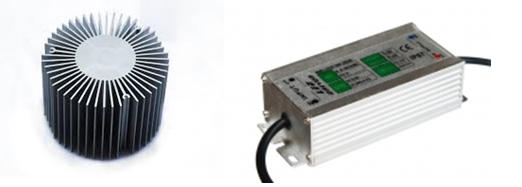
A conversion in this version will cost $35-40, but ready-made solutions of similar power start at $100-120.
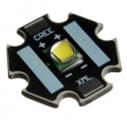 When creating a similar design using three bright LEDs for a Cree XM-L2 T6 10W flashlight, the design will cost almost half as much due to the lower cost of the drivers and the diodes themselves.
When creating a similar design using three bright LEDs for a Cree XM-L2 T6 10W flashlight, the design will cost almost half as much due to the lower cost of the drivers and the diodes themselves.
All information about calculating the power driver and the correct connection of LEDs can be found in the articles on our website.
A budget option for a homemade bright flashlight
The best option for a flashlight would be a compact diode with a power of up to 1 W. Diode supply voltage 3.2-3.6 V, current consumption 300 mA, luminous flux 100 lumens. The relatively low power will allow you to do without a cooling radiator.
With a light emitter size of 25 x 25 mm, it is possible to install 9 such LEDs with a total brightness of 900 lumens. It is possible to use a budget current stabilizer LM317 as a driver. With a total current consumption of up to 2700 mA, this flashlight can be powered from two AA batteries.
The total cost of refurbishment will not exceed ten dollars.
Amateur flashlight- used in Everyday life. In terms of light power and protection from adverse influences, it is inferior to professional models, but is superior in price.
Professional flashlight- designed for special tasks, characterized by high luminous power, moisture, dust, shock protection, and a large number of operating modes. Used by security guards, rescuers, divers, military, sailors and other specialists. The professional model costs much more than the amateur one.
Type
Flashlight- occurs most often, is represented by several types:
- manual compact- optimal balance between functionality and small size, sufficient for daily household needs;
- manual full size- compares favorably with the previous version with higher luminous flux power and wider functionality;
- tactical- installed on a weapon and used as a target designator, and also blinds the enemy; characterized by high power.
Hand-held flashlights also include tourist ones, which are used by outdoor enthusiasts. This lamp comes in two types:
- portable- the flashlight’s light beam is directed perpendicular to the body, and the device itself is equipped with a hook (hangs from clothing, freeing your hands);
- camping (lantern-lamp)- used for all-round lighting of camping, tents, construction sites and similar objects. Characteristic features: diffused light and wide beam.
Important: When choosing a camping flashlight, make sure it has sufficient power and battery life based on the conditions of use.
Head Torch- unlike the manual analogue, it is put on the head using an elastic band or strap. As a result, your hands are freed, and the light beam is always directed towards the person’s gaze. It has a limited luminous flux power and is comparable in capabilities to a hand-held compact flashlight.
A headlamp is used by miners, speleologists, stalkers, and is also useful for cyclists.
Important: To work with objects that are close to the user, it is worth purchasing a headlamp with adjustable brightness. This will reduce eye fatigue.
Underwater flashlight (for diving)- used for working underwater when examining the sea or river bottom. It features bright colors (makes it easier to find a fallen flashlight under water), high luminous flux power and a waterproof case. Recommended for divers, video and video film connoisseurs, and underwater hunters.
Important: The diving flashlight is equipped with a cooling system to work underwater. For this reason, it is not advisable to turn on the lamp outside of water at maximum power - it may overheat.
Keychain flashlight- the most compact model that will always be at hand (keychain with keys). It has too little luminous flux power, which is only enough for simple tasks, such as illuminating a keyhole. The keychain flashlight is designed for one operating mode and does not have focusing or filters.
Flashlight shocker- combines a lamp and a stun gun. It is distinguished by a long, heavy and durable body that can act as a baton. The downside is the high cost. The optimal solution for self-defense.
On sale there is also such a type of lantern as manual lamp. This is a powerful stationary model with large sizes and a weight that can be carried. Such a device often has special devices for adjusting the lighting (swivel heads, adjustable stands).
Design
The hand-held flashlight consists of head, central(“body”) and tail parts (cover). The head part contains a light source, a reflector and other elements, such as buttons. The central part is reserved for batteries or an accumulator, and buttons can be located in the tail part.
When inspecting a hand-held flashlight, you should pay attention to the following design details:
- head part- replaceable, equipped with light filters and attachments (multifunctional solution);
- central part- rubberized or corrugated (the flashlight will not slip out of wet hands or gloves);
- tail section- with flat stops (allows you to install the flashlight in a vertical position).
The headlamp is performed in united case (low-power models) or has a spaced design consisting of two separate parts - a lighting unit (light source, reflector) and a power source (battery, batteries), attached to the belt. The two housings are connected to each other with a special wire. This design allows you to increase the power of the headlamp.
The design of a diving flashlight is determined by its power: compact and relatively low-power hand-held flashlights, heavy and powerful models consisting of two bodies (flashlight + power source).
Light source
Incandescent lamp- has low efficiency (energy is converted into heat), does not last long, does not tolerate mechanical stress well and consumes a lot of electricity. These disadvantages are more significant than the individual advantages: relatively low price, simplicity of design, and the color of the glow familiar to the human eye. In modern flashlights, incandescent lamps are becoming less and less common.
Types of incandescent lamps.
- Krypton lamp- beats the classic analogue in compactness and low cost. Budget models are equipped with a similar light source.
- Xenon lamp- the characteristics resemble the previous version. Features: relatively high cost and whiter color.
- Halogen lamp- has a brighter glow and a longer service life. The disadvantage is the high price. Such lamps can be found in some hand-held lanterns.
Light Emitting Diode (LED)- characterized by high efficiency, resistance to mechanical stress and low temperature, long service life and economical energy consumption. The design of the LED makes it possible to expand the functionality of the lamp (quick switching on, several operating modes). LED is used in the vast majority of flashlights.
Disadvantages of LEDs: high price, uneven luminous flux, complex design, “cold” color glow, unusual for vision and distorting the perception of the real color of the object.
Fluorescent Lamp- in terms of efficiency and durability, they occupy a middle position between an incandescent lamp and LEDs. In addition, such lamps are toxic and not resistant to mechanical stress. Rarely used in flashlights.
Laser- features a powerful light beam. This flashlight provides a long illumination range, but the luminous flux is very narrow. The laser model is good as a target designator (for hunting).
Important: If handled carelessly, the laser light can cause irreparable damage to your eyesight.
Characteristics
Optical system- concentrates light radiation in one direction. In budget options, such a system is often absent, but more expensive models are equipped with a reflector, which concentrates the light beam in the required direction.
Reflectors are divided into two groups:
- smooth- form a long-range and narrow luminous flux with very high brightness in the center (the optimal solution for hunters and tourists);
- textured (crumpled)- provide uniform flood light covering a large area close to the user (the right choice for home use).
Number of diodes in the flashlight- directly determines the power and uniformity of the luminous flux of the flashlight. In hand-held models and keychain flashlights, 1 LED is installed, but in more powerful models, the number of LEDs is 2-5 pieces.
Models with a larger number of diodes are more powerful and durable, as they continue to work even if one or more LEDs break down. In addition, several diodes provide a uniform light output. As the number of diodes increases, the price and dimensions of the lamp, as well as energy consumption, increase. Moreover, even one LED provides brightness sufficient for household needs.
Maximum luminous flux (luminous power)- measured in lumens (lm). This value means the maximum brightness that the lamp produces. The greater the luminous flux, the brighter the glow and the higher the illumination range. True, an increase in light power leads to an increase in energy consumption and a reduction in the operating time of the flashlight.
In addition to the maximum luminous power, the minimum luminous flux is also indicated. These values form the range within which the brightness of the device is adjusted, for example, 70-275 lm; 10-350 lm and so on.
Light power depends on the type of flashlight:
- keychain flashlights, compact lamps - 10-20 lm;
- tourist flashlights, some headlamps - 30-100 lm (some models for the forehead - 200 lm and above);
- powerful tourist lamps, tactical flashlights, diving models - 100-300 lm;
- heavy-duty flashlights - 500 lm and above.
For domestic needs, flashlights with a light output of 30-100 lm are sufficient.
Number of brightness modes- the more modes there are, the more accurately you can adjust the brightness of the flashlight for a specific situation (lowering the brightness saves battery power). Most lamps have one brightness level.
Brightness Modes:
- ultra-low(up to 3 lm) - for reading the program in the theater;
- short(3-15 lm) - for illuminating a keyhole, illuminating a small area in a dark entrance;
- average(15-50 lm) - to find the road in the dark, this mode is used most often;
- high(50-150 lm) - for orienteering in the forest at night;
- ultrahigh(150 lm and above) - for working underwater, illuminating distant objects and similar special tasks.
Other operating modes expand the capabilities of the flashlight. The most common modes:
- flashing(1 flash every 1-3 seconds) - used as a signal for orientation;
- strobe(several flashes per second) - used to give a conditioned signal, ensures the visibility of a person to other road users at dusk, tracking moving objects, protection from animals;
- SOS(3 short - 3 long - 3 short flashes) - classic international distress signal.
These modes will be useful for lovers of an active lifestyle, as they will help preserve life in an extreme situation.
Lighting range- allows you to evaluate the capabilities of the flashlight in relation to its operating conditions. This characteristic is influenced by the light power and design of the device.
Manufacturers may indicate the ratio of illumination range to the selected brightness mode in the form proportions: 200 m / 70 lm, 283 m / 138 lm; 400 m / 275 lm; 63m/10lm, 329m/160lm, 490m/350lm and so on.
Lamps with a narrow beam provide a greater illumination range than analogues that scatter light.
Maximum operating time- the larger this parameter, the longer you can use the lamp without changing the battery / without recharging the battery. At the same time, such models increase in price, weight and dimensions. Many flashlights designed for long battery life have low power.
Manufacturers often associate the maximum time with the selected brightness modes: 7 hours 30 minutes / 70 lm, 4 hours / 138 lm, 2 hours / 275 lm; 50 h / 10 lm, 4 h / 160 lm, 2 h / 350 lm and so on.
“Long-lasting” flashlights will be needed by specialists who spend a long time in “wild” conditions (tourists, military, researchers). For most users, a 10-hour lamp is sufficient. This time is enough even for out-of-town trips.
Important: The maximum operating time is indicated by manufacturers based on “ideal” conditions (suitable temperature, energy saving, no additional modes). In practice, this “ideal” characteristic will be adjusted downward.
Nutrition
Batteries- unlike the model with a battery, it does not depend on the electrical network, which significantly increases the battery life of the flashlight away from urban conditions. You can always take several sets of batteries with you. The downside is the cost of periodically replacing batteries.
A battery-powered flashlight is good for rare use (infrequent trips out of town).
Important: Among the variety of battery-powered lamps, it is better to give preference to models designed for AA and AAA - the most common batteries. Other batteries are less available. For camping lanterns, C and D batteries are the best solution.
Battery- more economical, you don’t have to buy and change batteries. Unlike a battery, a battery cannot be replaced quickly, which means that a discharged lamp in “wild” conditions will become useless. However, charging the battery takes a long time.
A battery-powered flashlight will be useful for tourists and workers who require it for work (watchman, technologist). But for people who use the lamp from time to time, this is not the best option, since long breaks in operation negatively affect the battery.
You can purchase a universal option - a flashlight with a rechargeable battery, which also runs on batteries. This solution is distinguished by the greatest autonomy and operating time: main mode (battery), additional mode (batteries).
Most often there are two types of batteries.
- NiMH- despite the relatively small capacity, it is still widespread. Standard size - AA and AAA (finger).
- Li-Ion- the capacity is several times higher than NiMH (with the same weight). This battery is highly reliable. The downside is the higher cost. Standard size - 18650.
The more powerful the flashlight, the more batteries it will need to operate (the quantity varies between 1-4 pieces).
Important: NiMH batteries are not always compatible with flashlights designed for batteries of the same size. At a lower supply voltage, the driver (flashlight electronics) will not start working, and at a higher voltage, it will break. The operating voltage of AA and AAA, C and D batteries is 1.5 V, while NiMH batteries of similar form factors are 1.2 V.
Method of charging the flashlight battery:
- 220V- from a household electrical network;
- 12V- from the cigarette lighter in the car (suitable for hand-held flashlights);
- from USB port- from a computer, laptop, tablet and other equipment with such a connector (including USB adapters to the mains);
- Dynamo machine- a manual generator that generates energy using human muscle power (an excellent option for tourists, rescuers, scientists and other people working in “wild” conditions);
- solar battery- generates current using solar energy. The battery is recharged in sunny weather and twilight, as well as when artificial light sources are operating. As in the previous case, this charging method is useful for people who are far from civilization.
Additionally
Frame- made of two materials:
- plastic- lightweight and comfortable for the hand, but not durable enough, the optimal solution for headlamps and tourist flashlights;
- metal(aluminum alloys) - durable and heavy, but at low temperatures it is unpleasantly cold on the hand.
From metal cases, a separate group is distinguished titanium- relatively light and comfortable for the hand, but equally durable. True, a lamp with a titanium body will cost more than models made of other metals, not to mention plastic counterparts.
Protection from moisture and dust of the case- ensures the flashlight's resistance to adverse external factors. The protection class is marked as follows: IPXX (the first digit means the level of protection from dust, the second - from moisture). The higher the index, the higher the protection.
Dive models have the most high level protection- IP68 (dustproof, against prolonged immersion in water for more than 30 minutes to a depth of more than 1 m). Models with a high protection class are more expensive, so you should buy them only if necessary.
The most common water protection classes:
- IPX4- protection against splashes from any direction;
- IPX5- protection from jets from any direction;
- IPX6- protection from sea waves or strong water jets;
- IPX7- short-term immersion to a depth of up to 1 m is allowed;
- IPX8- long-term work is allowed at a depth of more than 1 m.
Protection against aggressive liquids- resistance to impact chemical substances(fuel, oil) that can damage the surface of the flashlight.
Impact protection- resistance to mechanical stress is useful in extreme conditions. Manufacturers usually indicate that the model can withstand a fall onto concrete from a height of 1; 2 or 3 m.
Length and weight- a compact and lightweight flashlight will always be at hand, but a large lantern is used only for specific tasks. At the same time, small size and weight always contradict the light power and versatility of a flashlight. Find a reasonable compromise between compactness, light output and device capabilities.
Length and weight of some lamps:
- manual compact - up to 20 cm, up to 200 g;
- manual full-size - over 20 cm, over 200 g;
- forehead - 70-100 g;
- flashlight-keychain - up to 10 cm, up to 50 g.
For convenient carrying in a bag, you should choose a flashlight up to 15 cm in size. Those who can sacrifice compactness for power should take a closer look at models from 20 cm. In particular, a long flashlight will be useful for a watchman for self-defense.
Most models weigh between 50-300 g, which does not tire your hand. But the weight of more powerful models increases to 500 g or more. This indicator is especially important for head-mounted devices, as they load the neck (it is recommended to choose models that do not exceed 70-100 g).
Functions
Brightness adjustment- there are two adjustment methods: stepwise and smooth. The second method is preferable, as it makes it possible to more accurately select the optimal mode.
Adjusting Focus- allows you to choose the desired solution from two opposite options (or something in between): a narrow light beam with a long illumination range, but with a small coverage of space, or a wide (diffused) light beam, illuminating a large area, but close to the user.
Charge indication- some models provide an LCD screen that accurately displays data; in other lamps, manufacturers limit themselves to an LED, which changes its color based on the battery charge level.
Light flux stabilization- provides a constant level of brightness of the light flux throughout the entire time the flashlight is used. An extremely useful feature.
Quick start- done by lightly pressing the button, which is then either released (the flashlight turns off) or pressed to the end (the flashlight continues to work). This button is good for sending arbitrary signals (Morse code).
Equipment
Nozzles (diffusers, filters)- expand the capabilities of the flashlight and allow you to change the direction or color of the light flux. With the help of diffusers, diffused light is obtained (good for illuminating a tent), and light filters turn the white light into red, blue or green (useful for hunting).
Strap- for fixing the lamp on the hand when unclenching the fingers. Sometimes the strap is used to carry a bulky lamp on the shoulder.
Clip- for attaching the flashlight to clothing.
Hook- performs a similar function as the clip, but is found mainly in tourist and camping models. Using a hook, a tourist lantern is hung on clothing or a backpack, and a camping lantern is hung on a rope or tree branch.
Fastening device(for tactical flashlights) - for installation on a unified rail.
Cable(for tactical flashlights) - to turn on the lamp from a distance.
memory- for charging the flashlight battery.
Case- protects the flashlight from adverse effects during storage and transportation. First of all, it protects against dirt and also protects against light impacts.
- Buy a flashlight in specialized stores, pay attention to products from well-known brands.
- Inspect the flashlight for damage and check that it is working properly.
- You should not choose a lamp with a complex control system.
- If you plan to hike through “difficult” terrain, in addition to the main flashlight, you should take a spare light (at least less powerful). This will allow you to feel more confident in the forest, cave, tunnel, even if the main flashlight fails.
- Read the terms and conditions of the warranty. Manufacturers of quality products provide a 5-year guarantee.
The rapid development of technology and its use in the production of the most common, everyday things familiar to humans, has a downside: the need for choice. An advertisement offering to buy this particular thing will readily describe all the advantages of the product, without mentioning a word about the shortcomings, which so often occur, serve as a continuation of the advantages or come from them. It's just a matter of proper use for its intended purpose. A striking illustration of the choice is the LED flashlight, which recently entered our everyday life.
What is a lantern anyway? This is a source of autonomous lighting. It must provide enough light to perform certain tasks for a sufficiently long period of time. The battery must be either recoverable or replaceable.
Advantages of LED lights
Are there any advantages to an LED flashlight over a conventional one equipped with an incandescent lamp? The undoubted advantages include:
Features of LED flashlight markings
Having decided on the fundamental choice, choosing an LED flashlight for specific tasks and purposes of use can be helped by information about the design features of various types of flashlights of this type. It would also be useful to know terminology and labeling used by manufacturers.

Design features of lanterns
Reflector
Available in one of two types: smooth or wrinkled. The focus and range of the beam depends on the choice of reflector. A smooth reflector produces a spot of light with a clearly defined central area and a sharp transition to an area of weak side illumination. In this case, an important criterion is the diameter of the reflector: better focusing can be provided by a reflector with a larger diameter. The crumpled reflector got its name because of its rough structure, the purpose of which is to smooth out the sharp transition from the central light spot to the peripheral area. Such a flashlight provides even illumination to a fairly wide area, but at the same time loses in illumination range.
Spectrum of light radiation
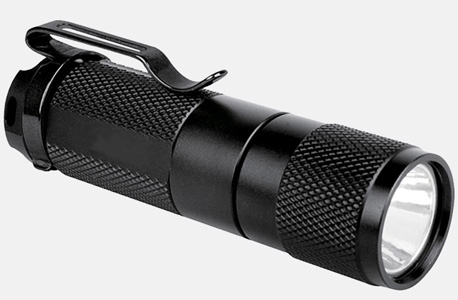 What to choose, warm or cold LED? The light emitted by various LEDs can range from the warm yellowish color of an incandescent bulb to the cool blue of a fluorescent bulb. The choice depends primarily on individual light perception, since some people do not tolerate the light of a fluorescent lamp. Next, you should start from the tasks and possible use of the flashlight. You should be aware that cold light has worse color rendering; complete color distortion is possible, especially the colors of the warm part of the spectrum, from red to yellow, and warm green. So, grass in the light from a blue diode can turn red grey colour. Therefore, it would be natural to use a flashlight with a warm LED in the open air - at the dacha, while fishing, on the road. Cold light seems brighter in human perception; its use in rooms where color rendering is not of decisive importance, or outdoors in winter, is quite appropriate. It would not be amiss to add that the use of an LED flashlight for professional purposes, where good lighting is required along with the reflection of all the nuances of the color scheme of objects, may be unacceptable.
What to choose, warm or cold LED? The light emitted by various LEDs can range from the warm yellowish color of an incandescent bulb to the cool blue of a fluorescent bulb. The choice depends primarily on individual light perception, since some people do not tolerate the light of a fluorescent lamp. Next, you should start from the tasks and possible use of the flashlight. You should be aware that cold light has worse color rendering; complete color distortion is possible, especially the colors of the warm part of the spectrum, from red to yellow, and warm green. So, grass in the light from a blue diode can turn red grey colour. Therefore, it would be natural to use a flashlight with a warm LED in the open air - at the dacha, while fishing, on the road. Cold light seems brighter in human perception; its use in rooms where color rendering is not of decisive importance, or outdoors in winter, is quite appropriate. It would not be amiss to add that the use of an LED flashlight for professional purposes, where good lighting is required along with the reflection of all the nuances of the color scheme of objects, may be unacceptable.
Batteries
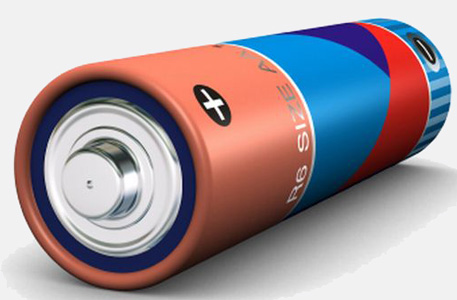 How to choose batteries batteries or accumulator, what to prefer? It is more profitable to use a battery charger if the flashlight is constantly in use, and it is possible to connect to electricity. Acquisition costs charger quickly pay for themselves. Batteries are absolutely necessary in rural or secluded areas where recharging is not possible. A supply of batteries will serve you well on a long hike or at a secluded dacha. Batteries, with their fairly long shelf life, are quite suitable for a flashlight that is intended to be used occasionally.
How to choose batteries batteries or accumulator, what to prefer? It is more profitable to use a battery charger if the flashlight is constantly in use, and it is possible to connect to electricity. Acquisition costs charger quickly pay for themselves. Batteries are absolutely necessary in rural or secluded areas where recharging is not possible. A supply of batteries will serve you well on a long hike or at a secluded dacha. Batteries, with their fairly long shelf life, are quite suitable for a flashlight that is intended to be used occasionally.
LED or xenon lamp
To choose an LED or a xenon lamp, you should consider the advantages of both in comparison.
Xenon lamp or HID lamp, based on a high intensity charge.
Her flaws similar to the disadvantages of a conventional incandescent lamp: fragility of the glass bulb, relatively large size and relatively short service life. The requirement for additional equipment is a special starting device, ballast and a battery capable of delivering high current.
Considered a significant drawback high price such lamps. Some flashlight manufacturers use a simplified version: a regular incandescent lamp with a spiral, under the bulb of which there is a coating of xenon or halogen vapor. Such lamps have some properties of xenon lamps, service life and efficiency are higher ordinary lamps incandescent
Her undoubted dignity considered to be high efficiency with the ability to focus well on a powerful light flux and good color rendering.
Let's consider the choice of flashlight according to the most popular areas of its application

Battery-powered LED flashlights provide fairly high light intensity. And their compact sizes allow you to take such devices with you on the road: on vacation, fishing, etc. In addition, the shock-resistant case of most models provides protection from mechanical damage.
What are they used for?
A self-powered LED flashlight is used to solve a variety of problems. Such devices cannot be called universal precisely because today the market offers a wide range of designs for a narrow area.
Certain models are used for search work, others are used in the fire department and police. A separate type of device was created for outdoor trips, fishing, and also for climbing climbers.
They represent a group of mobile technology. Considering that most models are used in difficult conditions, the design provides for a shock-resistant and vibration-resistant housing. Depending on the intensity of the luminous flux, these devices can be used as the main and additional light source for local lighting.
Existing types
As the popularity of LED products is rapidly increasing, the range of different types of models is expanding. The LED flashlight is available in two versions, different in design:
- forehead;
- manual type.
From the names of both options you can tell about the purpose of the devices, for example, headlight sources are equipped with a special mount so that you can free your hands by installing a rechargeable flashlight on your head. The second type is comfortable to hold in your hand.
Types of flashlights
In addition, there are different types that differ in the type of power source:
- on batteries that will have to be changed regularly;
- equipped with a battery.
The last of these options requires the use of a charger, which means that such a flashlight is useless when hiking/fishing/hunting due to the lack of a voltage source.
But if the device is used every day, then it is more economically feasible to purchase a rechargeable light source.
Self-powered flashlights are also divided into groups according to different purposes, which is largely due to design features:
- Household executions. They are compact, have a medium glow intensity, and for greater convenience are usually equipped with a hand cord. Household LED flashlights are used irregularly; most often they are purchased for use during a power outage at home or in an apartment, as well as in case of unscheduled repair work.
- Search lights. First of all, they are characterized by high operating efficiency. The glow range of some models reaches 450 m. In addition, the design provides a fairly spacious battery compartment. Number of light-emitting diodes – 3 pcs. Another advantage is that you can change the lighting angle, and for convenience there are several operating modes.
- Tourist performances. They include three types of light sources: head-mounted, hand-held and stationary. The last of these options is more often used in camping; it is convenient to place it on a table or hang it, for which the design provides a handle.
- Firefighting performances. They are distinguished by high luminescence intensity, compactness, impact-resistant and explosion-proof housing.
- Police battery light sources are characterized by a long handle and are called a “baton light”.
Each type is represented by a large number of designs, which allows you to choose a light source to suit your requirements.
How to make a choice
The first most important criterion is the type of device. It is necessary to select a flashlight based on how regularly it will be used and under what conditions. Next, it is important to determine the power of the luminous flux. This parameter must correspond to the intended illumination area so that the required level of visibility can be ensured.
It is not uncommon for a rechargeable flashlight to operate in different modes. The simplest household versions do not require changes in operating parameters. The type of power source is determined, again, based on how often the flashlight will be turned on.
Another criterion is the degree of protection of the case, which will protect the device from mechanical damage from shocks and falls, as well as from dust and moisture, if necessary.
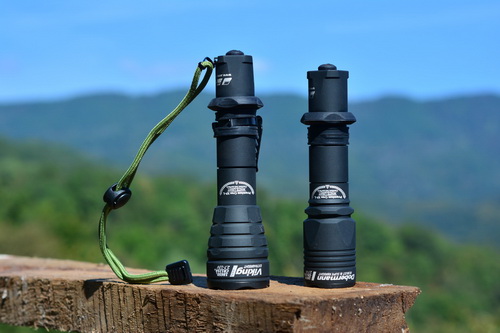
Armytek Dobermann models
Additionally, you should pay attention to the quality of the product. One of the options is a rechargeable flashlight from the Armytek Dobermann Pro brand. Its price is very high (RUB 3,600), but it is a professional design that works effectively at a distance of up to 450 m. It is possible to change operating modes: from maximum lighting intensity to minimum level.
Another, much more affordable option is Cree Led 2916 8000 W, offered at a price of 1,000 rubles. This is a pocket flashlight with high strength characteristics, which is equipped with a battery. This model is also resistant to moisture. It is possible to change lighting settings.














